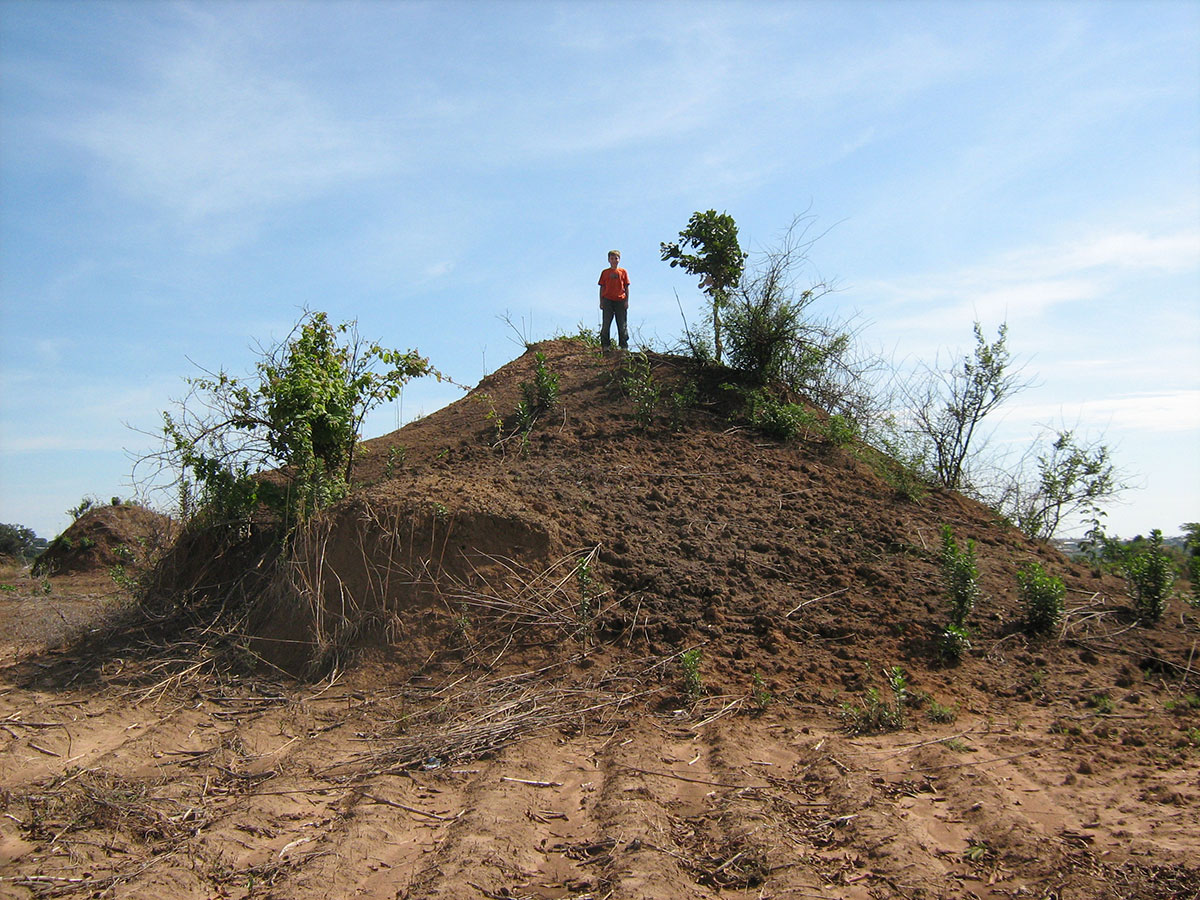Yes, African anthills and termite mounds are often impressive structures, much larger than what you might expect to find in a backyard garden, but tiny insects can’t come close to competing with commercial fertilizer manufacturers. Or can they?
When amateur household gardeners spot anthills in their gardens they grow concerned. Ants are thought to thrive in poor soils, after all. But farmers across Africa are increasingly viewing anthills and termite mounds as promising resources to be eagerly sought after and exploited, sometimes excessively.
Researchers have followed with interest cases of sub-Saharan African smallholder farmers digging up and hauling anthill soils to spread on their fields as fertilizers. The practice has been documented in Malawi, Niger, Sierra Leone, Tanzania, Uganda, and Zimbabwe, and lately fertilizing with anthills is gaining in popularity in parts of Zambia. It’s hard work, but farmers say it pays off, testifying to how anthill soil-as-fertilizer helps grow higher yields of maize. Other farmers use anthill soils to raise pumpkins, sorghum, onions, tomatoes, and other produce. There is plenty of anecdotal evidence that it works, but less hard evidence as to how or why. As Tanzanian scientist Kafula Chisanga and his team reported in their 2017 study published in the International Journal of Biosciences, there is “scanty information on the characteristics of suitable anthills for use in agriculture production,”.
Researchers believe that anthill soils help retain soil moisture, but so does manure, and manure is often easier to come by since many farmers also raise livestock. Researchers generally agree that the appeal of anthill and termite mound soils probably has something to do with the relatively high concentration of organic material, nitrogen, and phosphorous found in them, as well as good bulk density, but they don’t know the ideal volumes of material required to see a noticeable difference. Yes, African anthills and termite mounds are often impressive structures, much larger than what you might expect to find in a backyard garden, but tiny insects can’t come close to competing with commercial fertilizer manufacturers. Or can they?
More recently, Chisanga and fellow agricultural scientists Ernest Mbega and Patrick Alois Ndakidemi investigated anthill soil fertilizer use in two communities in southern Zambia, Choma and Pemba. Anthill soil excavation for farming has become commonplace in these communities over the past five years, and the researchers wanted to know exactly why this is the case, and precisely how farmers were benefiting from the practice.
The “why” they now pretty well understand—as they retell it in the journal Sustainability, struggling Zambian smallholder farms were dealt a blow by a recent spike in fertilizer prices, thus they turned to free anthill and termite mound soils as a cheap and readily available substitute. This is a case where anthill dirt does compete successfully against commercial fertilizer, and the farmers aren’t simply digging up random anthills they come across. “They target specific anthills for use for fertilizer in their agricultural production,” Chisanga explained to Grow Further. “These anthills must have vegetation in the form of some grasses, or small trees around to confirm that they are rich in nutrients.” Anthill soils seem to be retaining their competitive edge over fertilizers as well. “Anthill soil utilization does not decline even if the price of fertilizer falls,” Chisanga added.
Answering the second question—precisely how farmers are benefiting from anthill soil fertilizer—will take more time. In their newer study, based on data from interviews conducted with a specialized smartphone application, Chisanga et al. found that farmers of Choma and Pemba in southern Zambia sing the praises of anthill soil fertilizer, but that their embrace of this resource comes with a price.
Farmers in Pemba and Choma’s study told Chisanga and his colleagues that fields fertilized with anthill soil tend to consume more water. They also acknowledged that digging up and hauling anthill soil is arduous, backbreaking work, and a shortage of hands often means they can’t collect all they need. Chisanga et al. also discovered that farmers are more or less learning as they go, relying on each other, and not scientists, for cues on how to best apply this resource to their crops. The answers they arrive at aren’t always correct according to science. For instance, past studies found that depositing anthill soils in rows yields the best results, but the farmers of Choma and Pemba have come to an agreement around spreading it evenly and thinly across fields. Despite this lack of clarity and ongoing struggles at farms, southern Zambia’s anthill soil excavators insist that they grow more food using this natural fertilizer than they would without it.
Farmers and researchers agree that there is room for improvement. “Despite these reported benefits of anthill soils, some smallholder farmers explained that they faced challenges which included a requirement of more water by the resource, inadequate labor at the household level, handling and transportation, and determining the required anthill soil quantities per unit of area such as a hectare,” the team wrote in their report. There is also general worry that there simply isn’t enough anthill soil to come by; overusing it may eventually see ants and termites vacating the region entirely. Other questions remain unanswered. For instance, Chisanga tells Grow Further that “there may be a need to conduct a detailed study on the species of termites and ants associated with anthills used for soil fertility improvement,” and he says he would like to research how the practice has fared during the ongoing COVID-19 pandemic because “in some situations the use may have declined, but there is still a doubt.”
Still, Chisanga et al. see enormous potential for anthill soil technology to transform smallholder farms. All that’s required is the right science and a suite of best practices, they argue. Work on how to use anthill fertilizer effectively and sustainably is the type of research–important to smallholder farmers yet largely overlooked–that Grow Further plans to support.
— Grow Further




